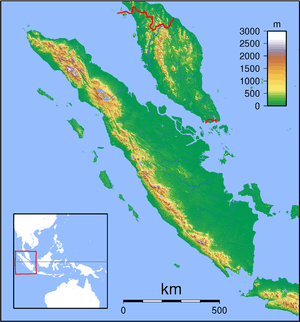2000 Enggano earthquake
 | |
| Date | June 4, 2000 |
|---|---|
| Origin time | 16:28:28 UTC [1] |
| Magnitude | 7.9 Mw [1] |
| Depth | 35 km (22 mi) [1] |
| Epicenter | 4°37′S 102°04′E / 4.61°S 102.06°ECoordinates: 4°37′S 102°04′E / 4.61°S 102.06°E [1] |
| Type | Strike-slip [2] |
| Areas affected | Indonesia |
| Max. intensity | VI (Strong) [3] |
| Aftershocks | 6.7 Mw June 4 at 14:39 [4] |
| Casualties |
103 dead [5] 2,174–2,585 injured [5] |
The 2000 Enggano earthquake struck at 23:28 local time on June 4 with a moment magnitude of 7.9 and a maximum Mercalli intensity of VI (Strong). The strike-slip event occurred off the coast of southern Sumatra, Indonesia near Enggano Island. There were more than 100 fatalities and up to 2,585 injuries. Over 730 aftershocks shocked the area afterwards, one just eleven minutes after the mainshock.
Background and tectonics
Indonesia is well known for strong earthquakes: the 2000 Sumatra event marked the beginning of an ongoing period of seismic activity in the area, highlighted by the 2004 Indian Ocean earthquake. This event was the only one of these earthquakes not to cause a tsunami.
Damage and casualties
Extensive damage and landslides populated the Bengkulu area, with minor injuries and damage on Enggano Island.[3] In the village worst struck, several hundred structures were reported in ruins.[6] Peter Walker of the International Federation of Red Cross and Red Crescent Societies in Geneva denied the earthquake as the major cause of death, instead blaming disease. "...the actual damage from the earthquake isn't that great; the houses are wooden structures so they don't collapse much. But what he found was an endemic problem of rampant malaria, rampant communicable diseases and levels of mortality and morbidity that are totally unacceptable. That is the disaster, not the earthquake."[7] An aftershock measuring 6.2 struck on June 7.[8]
Aftermath and response
International relief teams arrived in the region within several days.[9] Relief efforts were impeded by fallen telephone poles, which blocked the supplies.[6] The main problem found in the affected areas was a lack of water supply and electricity, these facilities having been cut off by oscillation.[6] Pope John Paul II expressed his "sincere sympathy" for those families stricken by the earthquake.[10] He called for a rapid international response to the quake, and said he would keep its victims in his prayers.[10] A Taiwanese rescue team was sent to help victims of the tremor, the first from the country to take part in rescue efforts aside from Asia. The United States donated US$ 25,000 instantly to relief organizations, Japan offering a grant of US$140,000 and Australia US$143,000 in addition to a two-person team of emergency relief examiners.[11]
Wharton Basin event
Two weeks later on June 18, another magnitude 7.9 event occurred about 1,000 kilometers (620 mi) to the southwest in the Wharton Basin. At the time, it was the largest intraplate earthquake in the Indian Ocean.[12]
See also
References
- 1 2 3 4 ISC (2014), ISC-GEM Global Instrumental Earthquake Catalogue (1900–2009), Version 1.05, International Seismological Centre
- ↑ Zhou, Y. H.; Xu, L. S.; Chen, Y. T. (2002), "Source Process of the 4 June 2000 Southern Sumatra, Indonesia, Earthquake", Bulletin of the Seismological Society of America, Seismological Society of America, 92 (5): 2027–2035, doi:10.1785/0120010212
- 1 2 USGS. "M7.9 - southern Sumatra, Indonesia". United States Geological Survey.
- ↑ USGS. "M6.7 - southern Sumatra, Indonesia". United States Geological Survey.
- 1 2 USGS (September 4, 2009), PAGER-CAT Earthquake Catalog, Version 2008_06.1, United States Geological Survey
- 1 2 3 "Indonesia appeals for help following Sumatran earthquake". RTÉ News. June 5, 2000.
- ↑ Tim Radford (July 6, 2000). "Just an everyday disaster". The Guardian. Retrieved June 4, 2009.
- ↑ "Photo Essay 6/8/2000 - Earthquake in Indonesia". Time Magazine. 2000-06-08. Retrieved 2008-07-29.
- ↑ UN Office for the Coordination of Humanitarian Affairs (2000), UNDAC Team Mission Report Bengkulu Earthquake, Sumatra, Indonesia 6–16 Jun 2000, ReliefWeb
- 1 2 "Pope Comforts Indonesian Quake Victims". Catholic World News. 2000-06-06.
- ↑ Catherine Sung (June 8, 2000). "Rescue team on the way". Taipei Times. Retrieved June 4, 2009.
- ↑ Abercrombie, R. E.; Antolik, M.; Ekström, G. (2003), "The June 2000 Mw 7.9 earthquakes south of Sumatra: Deformation in the India–Australia Plate", Journal of Geophysical Research, Wiley, 108 (B1), Bibcode:2003JGRB..108.2018A, doi:10.1029/2001JB000674
Sources
- Milsom, J.; Abercrombie, R. E. (2003). The June 2000 Enggano earthquake, South Sumatra, and the role of the Mentawai Fault. EUG Joint Assembly, Abstracts from the meeting held in Nice, France, 6–11 April 2003.
External links
- M7.9 Enggano Island-Bengkuku Earthquake, 2000 – Amateur Seismic Centre